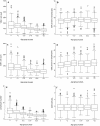Population-based hematologic and immunologic reference values for a healthy Ugandan population
- PMID: 14715541
- PMCID: PMC321349
- DOI: 10.1128/cdli.11.1.29-34.2004
Population-based hematologic and immunologic reference values for a healthy Ugandan population
Abstract
To assess the validity of the reference values for hematologic and immunologic indices currently used in Africa, we evaluated blood samples from 3,311 human immunodeficiency virus (HIV)-negative Ugandans aged 1 week to 92 years. Erythrocyte, hemoglobin, and hematocrit levels and mean corpuscular volume all significantly increased with age (P < 0.001) and were independent of gender until the age of 13 years, after which the levels were higher in males than in females (P < 0.001). White blood cell, neutrophil, lymphocyte, basophil, and monocyte counts significantly declined with age until the age of 13 years (P < 0.001), with no differences by gender, while platelet counts declined with age (P < 0.001) and showed differences by gender only among adults older than age 24 years. CD4+- and CD8+-cell counts declined with age until the age of 18 years; thereafter, females had higher counts than males. The absolute values for many of these parameters differed from those reported for populations outside Africa, suggesting that it may be necessary to develop tables of reference values for hematologic and immunologic indices specific for the African population. This may be particularly important with regard to CD4+-cell counts among children because significant differences in absolute and percent CD4+-cell counts exist between the values for Western populations and the values for the population evaluated in our study. These differences could influence the decision to initiate antiretroviral therapy among children infected with HIV.
Figures

References
-
- Azikiwe, A. N. 1984. Platelet count values in healthy Nigeria medical students in Jos. East Afr. Med. J. 61:482-485. - PubMed
-
- Badenhorst, C. J., J. Fourie, K. Steyn, P. L. Jooste, C. J. Lombard, L. Bourne, and W. Slazus. 1995. The haematological profile of urban black Africans aged 15-64 years in the Cape Peninsula. East Afr. Med. J. 72:19-24. - PubMed
-
- Coetzee, M. J., P. N. Badenhorst, J. I. de Wet, and G. Joubert. 1994. Haematological condition of the San (Bushmen) relocated from Namibia to South Africa. S. Afr. Med. J. 84:416-420. - PubMed
Publication types
MeSH terms
LinkOut - more resources
Full Text Sources
Research Materials

